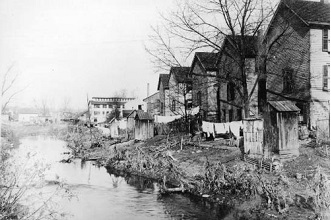Where Does Bronxville's Sewage Go?

By Ellen Edwards
Apr. 18, 2018: Did you know that the Bronx River Parkway was built to solve a problem? In 1898, the Bronx River was being used as an open sewer by farms, businesses, and private outhouses. Built atop new underground sewer lines, and completed in 1925, the parkway was the first U.S. roadway designed as part of a park.
Bronxville falls largely within the Bronx Valley Sewer District, one of the largest of thirteen districts throughout Westchester that are based on the original sewer lines laid down 100 years ago. Such districts do not follow town borders; most towns are served by two districts, and a tiny northeast portion of Bronxville falls within the Hutchinson District. Many communities in northern Westchester rely on private septic systems, which limits the density of the housing allowed there, but lower Westchester is served entirely by municipal sewer systems.
In Bronxville, the sewage and storm drain run-off have separate lines. Through gravity and two pumping stations, raw sewage is sent to the municipally owned Yonkers Joint Wastewater Treatment Plant, on Ludlow Docks, Yonkers. This is a mile-long, open-air water treatment facility on the banks of the Hudson River. Maintained by the Westchester Department of Environmental Facilities, it serves almost 505,000 people, or 55% of the county’s population, in 22 municipalities.
The Ludlow Facility handles 100 million gallons of sewage a day. It can handle up to 300 million gallons per day, but beyond that, the excess overflows directly into the Hudson River with minimal chlorine treatment—obviously a far-from-ideal situation. This situation can occur during storms with a high velocity of rainfall. According to Bronxville Village Administrator Jim Palmer, "infiltration" occurs when ground water seeps into the sanitary sewer system through cracks in someone's sanitary sewer lateral (the line running from the house to the main line) or through cracks in the village's sanitary sewer lines. This infiltrated water ends up being treated at the Yonkers sewage treatment plant, which means that excess water is added to the "inflow" and taxpayers are spending money to pump and treat storm water in wastewater. Sometimes, too, there is inflow when someone has illegally tied a sump pump or their gutters into the sanitary sewer system. Instead, gutters should be tied to either a catch basin or to a dry well on a resident's property. As our weather becomes subject to stronger storms, such infiltration and inflow are bound to be of increasing concern.
The sewage that arrives at the Yonkers facility has been described as looking like chocolate milk, a slurry of fecal matter and dissolved toilet paper. A bar screen removes the trash. This can include feminine hygiene products, facial tissue and “flushable” wipes, and plastic bags. Removed trash is disposed of separately.
The resulting slurry then receives a complex series of treatments. Primary treatment includes using gravity to remove inorganic material, such as grit, and up to 10% of dissolved solids. Secondary treatment includes using bacteria and microbes that naturally occur in the gut to eat 85% of the dissolved solids. The resulting “sludge cake” is further treated—water is extracted and impurities removed with the help of sludge digesters and sludge centrifuges—until the leftover material is turned into a farm-ready fertilizer. The remaining water, which is now quite clean, is further treated and then released into the Hudson River.
These processes require lots of energy. Solar panels on the Ludlow facility provide 3% of the plant’s electricity needs. Bacteria that feed on the sewage produce methane and carbon dioxide; an anaerobic gas digester captures the methane and uses it to help run the boilers and heat the facility. Excess digester gas is burned at four waste burners, or flares. A mist scrubber system helps control odors.
Jim Palmer says the village is also obligated under state law to ensure the integrity of the village's separate storm sewer system and report each year on the village's efforts to the state's Department of Environmental Conservation (DEC). The village is obligated to meet six minimum control measures, including the number of catch basins that are cleaned and repaired every year, the number of streets that are swept, and efforts to control sediment runoff from construction sites, etc. The community must also be informed of, among other points, the importance of making sure that dog waste doesn't end up in a catch basin, making sure that a homeowner's sanitary sewer line does not tie into a storm water pipe, and even ensuring that only organic car wash cleansers are used to wash a car. Such rigorous adherence to the law is essential because run-off through the storm sewage system flows directly into surface water, primarily the Bronx River. The 2017-2018 report on these efforts will be made available at the village board meeting in June. Residents can find the 2016-2017 report along with other useful information on the village's website on the public works home page.
Like much of Westchester’s infrastructure, its sanitary sewer and storm sewer systems are old and in need of repair. Jim Palmer confirmed that the village has taken great strides in recent years to clean, replace, and line the town's sanitary sewer system, as well as undo illegal connections. In the fall of 2017, Bronxville publications reported on the completion of a multi-year project that involved surveying the system and repairing 15 main sewer lines and 13,500 linear feet of primary sewer lines in town. More repair work is also taking place this year. The new cured-in-place pipes are designed to last 50 years.
You can help ensure the continued life of Bronxville’s sewer pipes and the efficient operation of our water treatment facility by never putting unauthorized waste down drains and storm drains and by ensuring that sewage lines on your property are in good repair.
A well-functioning sewer system and up-to-date water treatment plant are part of the infrastructure we take for granted, but they’re complex, expensive, and in need of continual upgrades and improvements. Bronxville’s sewer system is essential for our clean environment and for our public health and safety—a government service paid for by our taxes that deserves our awareness and support.
Correction: May 2, 2018
An earlier version of this article incorrectly stated that in Bronxville the sewage and storm drain run-off share the same sewer lines. The sewage and storm drain run-off have separate lines. This revised version also includes discussion of infiltration and of the village's obligations to ensure the integrity of the separate storm sewer system, in addition to several other clarifications.
Editor's note: Ellen Edwards is a Bronxville resident and a member of the Bronxville Green Committee, which welcomes volunteers.
Pictured here: A picture of the Bronx River in 1912 in the Westchester County virtual archives with the following description: "This photograph is a good example of the polluted condition of the Bronx River before the Bronx River Parkway Reservation, as many privies are shown in close proximity to the water. Location of photograph: White Plains - New York."
Photo is in the public domain and is in the Virtual Archives, a collaborative effort of the Westchester County Archives and the Westchester County Historical Society, at http://www.westchesterarchives.com/BRPR/Photos_hist_fr.html.
Editor's note: As a public service, MyhometownBronxville publishes press releases, statements, and articles from local institutions, officeholders, candidates, and individuals. MyhometownBronxville does not fact-check statements therein, and any opinions expressed therein do not necessarily reflect the thinking of its staff.
Government & History Directory
Bronxville is a quaint village (one square mile) located just 16 miles north of midtown Manhattan (roughly 30 minutes on the train) and has a population of approximately 6,500. It is known as a premier community with an excellent public school (K-12) and easy access to Manhattan. Bronxville offers many amenities including an attractive business district, a hospital (Lawrence Hospital), public paddle and tennis courts, fine dining at local restaurants, two private country clubs and a community library.
While the earliest settlers of Bronxville date back to the first half of the 18th century, the history of the modern suburb of Bronxville began in 1890 when William Van Duzer Lawrence purchased a farm and commissioned the architect, William A. Bates, to design a planned community of houses for well-known artists and professionals that became a thriving art colony. This community, now called Lawrence Park, is listed on the National register of Historic Places and many of the homes still have artists’ studios. A neighborhood association within Lawrence Park called “The Hilltop Association” keeps this heritage alive with art shows and other events for neighbors.
Bronxville offers many charming neighborhoods as well as a variety of living options for residents including single family homes, town houses, cooperatives and condominiums. One of the chief benefits of living in “the village” is that your children can attend the Bronxville School.
The Bronxville postal zone (10708, known as “Bronxville PO”) includes the village of Bronxville as well as the Chester Heights section of Eastchester, parts of Tuckahoe and the Lawrence Park West, Cedar Knolls, Armour Villa and Longvale sections of Yonkers. Many of these areas have their own distinct character. For instance, the Armour Villa section has many historic homes and even has its own newsletter called “The Villa Voice” which reports on neighborhood news.
Link to Village of Bronxville One Square Mile Monthly Newsletter
Village of Bronxville Administrative Offices
337-6500
Open 9:00am - 4pm excluding holidays and weekends
Bronxville Police Department
337-0500
Open 24 hours
Bronxville Parking Violations
337-2024
Open 9:00am - 4pm excluding holidays and weekends
Bronxville Fire Deparment
793-6400













